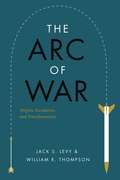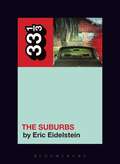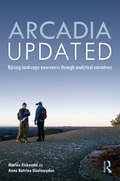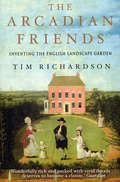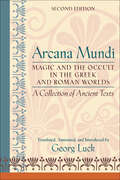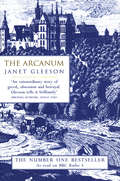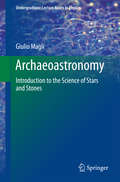- Table View
- List View
Arboreal Symbolism in European Art, 1300–1800 (Routledge Research in Art and Religion)
by Katherine T. BrownArboreal Symbolism in European Art, 1300–1800 probes the significance of trees in religious iconography of Western art.Based in the disciplines of art history, botany, and theology, this study focuses on selected works of art in which tree forms embody and reflect Christian themes. Through this triple lens, Brown examines trees that early modern artists rendered as sacred symbols—symbols with origins in the Old Testament, New Testament, Greek and Roman cultures, and early medieval legends. Tree components and wood depicted in works of art can serve as evidence for early modern artists’ embrace of biblical metaphor, classical sources, and devotional connotations. The author considers how artists rendered seasonal change in Christian narratives to emphasize themes of spiritual transformation. Brown argues that many artists and their patrons drew parallels between the life cycle of a tree and events in the Gospels with their respective annual, liturgical celebrations.This book will interest scholars in art history, religion, humanities, and interdisciplinary studies.
Arc of Containment: Britain, the United States, and Anticommunism in Southeast Asia (The United States in the World)
by Wen-Qing NgoeiArc of Containment recasts the history of American empire in Southeast and East Asia from World War II through the end of American intervention in Vietnam. Setting aside the classic story of anxiety about falling dominoes, Wen-Qing Ngoei articulates a new regional history premised on strong security and sure containment guaranteed by Anglo-American cooperation.Ngoei argues that anticommunist nationalism in Southeast Asia intersected with preexisting local antipathy toward China and the Chinese diaspora to usher the region from European-dominated colonialism to US hegemony. Central to this revisionary strategic assessment is the place of British power and the effects of direct neocolonial military might and less overt cultural influences based in decades of colonial rule. Also essential to the analysis in Arc of Containment is the considerable influence of Southeast Asian actors upon Anglo-American imperial strategy throughout the post-war period. In Arc of Containment Ngoei shows how the pro-US trajectory of Southeast Asia after the Pacific War was, in fact, far more characteristic of the wider region's history than American policy failure in Vietnam. Indeed, by the early 1970s, five key anticommunist nations—Malaya, Singapore, Philippines, Thailand, and Indonesia—had quashed Chinese-influenced socialist movements at home and established, with U.S. support, a geostrategic arc of states that contained the Vietnamese revolution and encircled China. In the process, the Euro-American colonial order of Southeast Asia passed from an era of Anglo-American predominance into a condition of US hegemony. Arc of Containment demonstrates that American failure in Vietnam had less long-term consequences than widely believed because British pro-West nationalism had been firmly entrenched twenty-plus years earlier. In effect, Ngoei argues, the Cold War in Southeast Asia was but one violent chapter in the continuous history of western imperialism in the region in the twentieth century.
The Arc of Due Process in American Constitutional Law
by E. Thomas Sullivan Toni M. MassaroTopics such as military tribunals, same-sex marriage, informative privacy, reproductive rights, affirmative action, and states' rights fill the landscape of contemporary legal debate and media discussion, and they all fall under the umbrella of the Due Process Clauses of the United States Constitution. However, what is not always fully understood is the constitutional basis of these rights, or the exact list of due process rights as they have evolved over time through judicial interpretation. In The Arc of Due Process in American Constitutional Law, Sullivan and Massaro describe the intricate history of what are currently considered due process rights, and maintain that modern constitutional theory and practice must adhere to it. The authors focus on the origins and contemporary uses of due process principles in American constitutional law, while offering an overarching description of the factors or normative concepts that allow courts to invalidate a government action on the grounds of due process. They also analyze judicial interpretations and expressions as a key manner and perhaps the most powerful source of how due process has taken form in the United States. In the process of charting this arc, the authors describe the judicial analysis of rights within each category applying an illustrative list, and identify several fundamental norms that span these disparate threads of due process and the most salient principles that animate due process doctrine.
The Arc of War: Origins, Escalation, and Transformation
by Jack S. Levy William R. ThompsonIn this far-reaching exploration of the evolution of warfare in human history, Jack S. Levy and William R. Thompson provide insight into the perennial questions of why and how humans fight. Beginning with the origins of warfare among foraging groups, The Arc of War draws on a wealth of empirical data to enhance our understanding of how war began and how it has changed over time. The authors point to the complex interaction of political economy, political and military organization, military technology, and the threat environment—all of which create changing incentives for states and other actors. They conclude that those actors that adapt survive, and those that do not are eliminated. In modern times, warfare between major powers has become exceedingly costly and therefore quite rare, while lesser powers are too weak to fight sustained and decisive wars or to prevent internal rebellions. Conceptually innovative and historically sweeping, The Arc of War represents a significant contribution to the existing literature on warfare.
The Arc of War: Origins, Escalation, and Transformation
by Jack S. Levy William R. ThompsonIn this far-reaching exploration of the evolution of warfare in human history, Jack S. Levy and William R. Thompson provide insight into the perennial questions of why and how humans fight. Beginning with the origins of warfare among foraging groups, The Arc of War draws on a wealth of empirical data to enhance our understanding of how war began and how it has changed over time. The authors point to the complex interaction of political economy, political and military organization, military technology, and the threat environment—all of which create changing incentives for states and other actors. They conclude that those actors that adapt survive, and those that do not are eliminated. In modern times, warfare between major powers has become exceedingly costly and therefore quite rare, while lesser powers are too weak to fight sustained and decisive wars or to prevent internal rebellions. Conceptually innovative and historically sweeping, The Arc of War represents a significant contribution to the existing literature on warfare.
The Arc of War: Origins, Escalation, and Transformation
by Jack S. Levy William R. ThompsonIn this far-reaching exploration of the evolution of warfare in human history, Jack S. Levy and William R. Thompson provide insight into the perennial questions of why and how humans fight. Beginning with the origins of warfare among foraging groups, The Arc of War draws on a wealth of empirical data to enhance our understanding of how war began and how it has changed over time. The authors point to the complex interaction of political economy, political and military organization, military technology, and the threat environment—all of which create changing incentives for states and other actors. They conclude that those actors that adapt survive, and those that do not are eliminated. In modern times, warfare between major powers has become exceedingly costly and therefore quite rare, while lesser powers are too weak to fight sustained and decisive wars or to prevent internal rebellions. Conceptually innovative and historically sweeping, The Arc of War represents a significant contribution to the existing literature on warfare.
The Arc of War: Origins, Escalation, and Transformation
by Jack S. Levy William R. ThompsonIn this far-reaching exploration of the evolution of warfare in human history, Jack S. Levy and William R. Thompson provide insight into the perennial questions of why and how humans fight. Beginning with the origins of warfare among foraging groups, The Arc of War draws on a wealth of empirical data to enhance our understanding of how war began and how it has changed over time. The authors point to the complex interaction of political economy, political and military organization, military technology, and the threat environment—all of which create changing incentives for states and other actors. They conclude that those actors that adapt survive, and those that do not are eliminated. In modern times, warfare between major powers has become exceedingly costly and therefore quite rare, while lesser powers are too weak to fight sustained and decisive wars or to prevent internal rebellions. Conceptually innovative and historically sweeping, The Arc of War represents a significant contribution to the existing literature on warfare.
The Arc of War: Origins, Escalation, and Transformation
by Jack S. Levy William R. ThompsonIn this far-reaching exploration of the evolution of warfare in human history, Jack S. Levy and William R. Thompson provide insight into the perennial questions of why and how humans fight. Beginning with the origins of warfare among foraging groups, The Arc of War draws on a wealth of empirical data to enhance our understanding of how war began and how it has changed over time. The authors point to the complex interaction of political economy, political and military organization, military technology, and the threat environment—all of which create changing incentives for states and other actors. They conclude that those actors that adapt survive, and those that do not are eliminated. In modern times, warfare between major powers has become exceedingly costly and therefore quite rare, while lesser powers are too weak to fight sustained and decisive wars or to prevent internal rebellions. Conceptually innovative and historically sweeping, The Arc of War represents a significant contribution to the existing literature on warfare.
The Arc of War: Origins, Escalation, and Transformation
by Jack S. Levy William R. ThompsonIn this far-reaching exploration of the evolution of warfare in human history, Jack S. Levy and William R. Thompson provide insight into the perennial questions of why and how humans fight. Beginning with the origins of warfare among foraging groups, The Arc of War draws on a wealth of empirical data to enhance our understanding of how war began and how it has changed over time. The authors point to the complex interaction of political economy, political and military organization, military technology, and the threat environment—all of which create changing incentives for states and other actors. They conclude that those actors that adapt survive, and those that do not are eliminated. In modern times, warfare between major powers has become exceedingly costly and therefore quite rare, while lesser powers are too weak to fight sustained and decisive wars or to prevent internal rebellions. Conceptually innovative and historically sweeping, The Arc of War represents a significant contribution to the existing literature on warfare.
Arcade Fire’s The Suburbs (33 1/3)
by Eric EidelsteinThe Suburbs is an incredibly sentimental and nostalgic album, which generally moved critics but was jarring to others. But it also made a heavy impact on fans and – to the surprise of many – won Album of the Year at the 2011 Grammy Awards. This immensely visceral album triggers a sincere celebration of not formative years spent in a cookie-cutter development, but of feeling self-important, immortal, and desperate to escape. It examines youth and amplifies an innate sense of longing and remembrance.Eric Eidelstein's The Suburbs explores this weird, utopic recollection of youth by comparing the album to suburban scenes in film and television, such as Blue Velvet, Mad Men, The Americans, and Spike Jonze's Scenes from the Suburbs. Through the close examination of film and televised depictions of the suburbs, both past and present, Eidelstein delves into the societal factors and artistic depictions that make the suburbs such a fascinating cultural construct, and uncovers why the album creates such a relatable and universal sense of reminiscence.
Arcade Fire’s The Suburbs (33 1/3)
by Eric EidelsteinThe Suburbs is an incredibly sentimental and nostalgic album, which generally moved critics but was jarring to others. But it also made a heavy impact on fans and – to the surprise of many – won Album of the Year at the 2011 Grammy Awards. This immensely visceral album triggers a sincere celebration of not formative years spent in a cookie-cutter development, but of feeling self-important, immortal, and desperate to escape. It examines youth and amplifies an innate sense of longing and remembrance.Eric Eidelstein's The Suburbs explores this weird, utopic recollection of youth by comparing the album to suburban scenes in film and television, such as Blue Velvet, Mad Men, The Americans, and Spike Jonze's Scenes from the Suburbs. Through the close examination of film and televised depictions of the suburbs, both past and present, Eidelstein delves into the societal factors and artistic depictions that make the suburbs such a fascinating cultural construct, and uncovers why the album creates such a relatable and universal sense of reminiscence.
Arcadia (Text Only): England And The Dream Of Perfection (text Only)
by Adam NicolsonThis ebook does not include illustrations. A fascinating depiction from award-winning author, Adam Nicolson, of a family and a country on the hinge of modernisation.
Arcadia Updated: Raising landscape awareness through analytical narratives
by Marius Fiskevold Anne Katrine GeelmuydenArcadia Updated delves into the concept of landscape as it is shaped by the literary tradition and material works known as pastoral. Referring to several of the tradition’s works as well as scholarly critiques, Fiskevold and Geelmuyden highlight how individual landscape perception is primarily a cultural construct: each individual may see a unique landscape based on personal experiences, but simultaneously, landscape represents a tradition of engaging with nature and land, which has been largely forgotten. In re-engaging and connecting the practice of understanding landscapes with the pastoral tradition, the authors establish a common ground for treating landscape as an object of analysis in landscape planning. Arcadia Updated contributes to the methodological debate concerning landscape character assessment. Including 30 black-and-white images, this book analyses how humans engage with land organically, materially and communicatively. It seeks to raise landscape awareness as both an individual and a collective act of imagination. The practice of analysing landscapes is an ongoing culture of reinterpreting the land as landscape in response to society’s development and technical progress. The role of the landscape analyst is to interpret the contemporary world and offer visual explanations of it. This book will be beneficial to professional landscape planners as well as to academics and students of landscape, literature and cultural studies. It provides an essential contribution to the cross-disciplinarity of the landscape discourse.
Arcadia Updated: Raising landscape awareness through analytical narratives
by Marius Fiskevold Anne Katrine GeelmuydenArcadia Updated delves into the concept of landscape as it is shaped by the literary tradition and material works known as pastoral. Referring to several of the tradition’s works as well as scholarly critiques, Fiskevold and Geelmuyden highlight how individual landscape perception is primarily a cultural construct: each individual may see a unique landscape based on personal experiences, but simultaneously, landscape represents a tradition of engaging with nature and land, which has been largely forgotten. In re-engaging and connecting the practice of understanding landscapes with the pastoral tradition, the authors establish a common ground for treating landscape as an object of analysis in landscape planning. Arcadia Updated contributes to the methodological debate concerning landscape character assessment. Including 30 black-and-white images, this book analyses how humans engage with land organically, materially and communicatively. It seeks to raise landscape awareness as both an individual and a collective act of imagination. The practice of analysing landscapes is an ongoing culture of reinterpreting the land as landscape in response to society’s development and technical progress. The role of the landscape analyst is to interpret the contemporary world and offer visual explanations of it. This book will be beneficial to professional landscape planners as well as to academics and students of landscape, literature and cultural studies. It provides an essential contribution to the cross-disciplinarity of the landscape discourse.
The Arcadian Friends
by Tim RichardsonBetween 1715 and 1750, a group of politicans and poets, farmers and businessmen, heiresses and landowners began to experiment with the phenomenon that was to become the English landscape garden. Arguably the greatest British art form ever invented, these gardens were built to charm and delight, to shock and inspire all who visited. That these gardens - including Castle Howard, Stowe, Painshill and Rousham - are still so popular with visitors today is a testament to the innovation and passion of this extraordinary group of eccentrics and visionaries.The Arcadian Friends takes a highly engaging perspective on the politics and culture of England during the Enlightenment. At the same time it will be required reading for the legions of fans of the great gardens of England.Tim Richardson introduces us to a period of poltical and personal intrigue, where fantastic biblical landscapes competed for space with temples to sexual freedom; and where the installation of a water feature was a political act. The Arcadian Friends tells the story of a collection of fascinating characters whose influence changed the landscape of Britain for ever.
Arcana Mundi: Magic and the Occult in the Greek and Roman Worlds: A Collection of Ancient Texts (Textes Litteraires Du Moyen Age Ser. #21)
by Georg LuckMagic, miracles, daemonology, divination, astrology, and alchemy were the arcana mundi, the "secrets of the universe," of the ancient Greeks and Romans. In this path-breaking collection of Greek and Roman writings on magic and the occult, Georg Luck provides a comprehensive sourcebook and introduction to magic as it was practiced by witches and sorcerers, magi and astrologers, in the Greek and Roman worlds. In this new edition, Luck has gathered and translated 130 ancient texts dating from the eighth century BCE through the fourth century CE. Thoroughly revised, this volume offers several new elements: a comprehensive general introduction, an epilogue discussing the persistence of ancient magic into the early Christian and Byzantine eras, and an appendix on the use of mind-altering substances in occult practices. Also added is an extensive glossary of Greek and Latin magical terms. In Arcana Mundi Georg Luck presents a fascinating—and at times startling—alternative vision of the ancient world. "For a long time it was fashionable to ignore the darker and, to us, perhaps, uncomfortable aspects of everyday life in Greece and Rome," Luck has written. "But we can no longer idealize the Greeks with their 'artistic genius' and the Romans with their 'sober realism.' Magic and witchcraft, the fear of daemons and ghosts, the wish to manipulate invisible powers—all of this was very much a part of their lives."
The Arcanum: The Extraordinary True Story Of The Invention Of European Porcelain
by Janet GleesonImprisoned in a fairy-tale castle and under constant threat of execution by his ruthless captor an 18th century apothecary struggled to realize the alchemist's dream. His name was Johann Frederick Bottger. But instead of transforming base metal into gold he was to discover the formula for something even more exotic and elusive, a substance so precious it was known as 'white gold'. And it was a formula for which others were prepared to lie, cheat, steal and even kill to possess.This was the remarkable backdrop to one of the most strange and compelling episodes in European cultural and scientific history; a tale of genius and greed, of demonic cruelty and exquisite beauty, of the best and worst of which man is capable - it is the true story of the invention of European porcelain.
Arcanum
by Simon MordenThe kingdom of Carinthia is rich, powerful and undefeated. A thousand years ago, its ancestors were the spell-wielding northern tribes who crushed the Roman Empire. Their legendary hexmasters can destroy whole armies and turn battlefields into fiery lakes of lava.Magic is Carinthia's wealth, protection and way of life. But the age of magic is dying. Some would do anything to see it return: any act, no matter how terrible, is justified, so long as the hexmasters can still protect their homeland.The kingdom is poised between order and chaos - and the smallest spark is the difference between disaster and triumph.ARCANUM is powerful new epic fantasy from an award-winning author.
Archaeoastronomy: Introduction to the Science of Stars and Stones (Undergraduate Lecture Notes in Physics)
by Giulio MagliThis book provides the first complete, easy to read, up-to-date account of the fascinating discipline of archaeoastronomy, in which the relationship between ancient constructions and the sky is studied in order to gain a better understanding of the ideas of the architects of the past and of their religious and symbolic worlds. The book is divided into three sections, the first of which explores the past relations between astronomy and people, power, the afterworld, architecture, and landscape. The fundamentals of archaeoastronomy are then addressed in detail, with coverage of the celestial coordinates; the apparent motion of the Sun, Moon, stars, and planets; observation of celestial bodies at the horizon; the use of astronomical software in archaeoastronomy; and current methods for making and analyzing measurements. The final section reviews what archaeoastronomy can now tell us about the nature and purpose of such sites and structures as Stonehenge, the Pyramids of Giza, Chichen Itza, the Campus Martius, and the Valley of the Temples of Agrigento. In addition, a set of exercises is provided that can be performed using non-commercial free software, e.g., Google Earth or Stellarium, and will equip readers to conduct their own research. Readers will find the book an ideal introduction to what has become a wide-ranging multidisciplinary science.
Archaeoastronomy: Introduction to the Science of Stars and Stones (Undergraduate Lecture Notes in Physics)
by Giulio MagliThis is a second edition of a textbook that provides the first comprehensive, easy-to-read, and up-to-date account of the fascinating discipline of archaeoastronomy, in which the relationship between ancient constructions and the sky is studied in order to gain a better understanding of the ideas of the architects of the past and of their religious and symbolic worlds. The book is divided into three sections, the first of which explores the past relations between astronomy and people, power, the afterworld, architecture, and landscape. The second part then discusses in detail the fundamentals of archaeoastronomy, including the celestial coordinates; the apparent motion of the sun, moon, stars, and planets; observation of celestial bodies at the horizon; the use of astronomical software in archaeoastronomy; and current methods for making and analyzing measurements. The final section reviews what archaeoastronomy can now tell us about the nature and purpose of such sites and structures as Stonehenge, the Pyramids of Giza, Chichen Itza, the Angkor Temples, the Campus Martius, and the Valley of the Temples of Agrigento. In addition, it provides a set of exercises that can be performed using non-commercial free software, e.g., Google Earth and Stellarium, and that will equip readers to conduct their own research. This new edition features a completely new chapter on archaeoastronomy in Asia and an “augmented reality” framework, which on the one hand enhances the didactic value of the book using direct links to the relevant sections of the author’s MOOC (online) lessons and, on the other, allows readers to directly experience – albeit virtually –many of the spectacular archaeological sites described in the book. This is an ideal introduction to what has become a wide-ranging multidisciplinary science.
Archaeological Ambassadors: A History Of Archaeological Gifts In New York City
by Elizabeth R. MacaulayArchaeological Hammers and Theories
by James A. Moore Arthur S. KeeneStudies in Archaeology: Archaeological Hammers and Theories provides information pertinent to the archeological method, with emphasis on the interaction of data and technique with theory and problems. This book describes the nature of archeological data, the range of archeological theories, and the scope of archeological problems.Organized into three parts encompassing 13 chapters, this book begins with an overview of the products of the archeological record. This text then examines survey sampling, site formation studies, and lithic and ceramic analysis. Other chapters consider the behavioral concepts that are implicit in the notions of special behavior, optimization, decision making, and population dynamics. This book discusses as well the analysis of pottery, which plays a leading part in the reconstruction of culture histories in archeology. The final chapter suggests an alternative set of philosophical issues that might serve to focus a philosophy or archeology.This book is a valuable resource for archeologists.
An Archaeological History of Indian Buddhism
by Lars FogelinAn Archaeological History of Indian Buddhism is a comprehensive survey of Indian Buddhism from its origins in the 6th century BCE, through its ascendance in the 1st millennium CE, and its eventual decline in mainland South Asia by the mid-2nd millennium CE. Weaving together studies of archaeological remains, architecture, iconography, inscriptions, and Buddhist historical sources, this book uncovers the quotidian concerns and practices of Buddhist monks and nuns (the sangha), and their lay adherents--concerns and practices often obscured in studies of Buddhism premised largely, if not exclusively, on Buddhist texts. At the heart of Indian Buddhism lies a persistent social contradiction between the desire for individual asceticism versus the need to maintain a coherent community of Buddhists. Before the early 1st millennium CE, the sangha relied heavily on the patronage of kings, guilds, and ordinary Buddhists to support themselves. During this period, the sangha emphasized the communal elements of Buddhism as they sought to establish themselves as the leaders of a coherent religious order. By the mid-1st millennium CE, Buddhist monasteries had become powerful political and economic institutions with extensive landholdings and wealth. This new economic self-sufficiency allowed the sangha to limit their day-to-day interaction with the laity and begin to more fully satisfy their ascetic desires for the first time. This withdrawal from regular interaction with the laity led to the collapse of Buddhism in India in the early-to-mid 2nd millennium CE. In contrast to the ever-changing religious practices of the Buddhist sangha, the Buddhist laity were more conservative--maintaining their religious practices for almost two millennia, even as they nominally shifted their allegiances to rival religious orders. This book also serves as an exemplar for the archaeological study of long-term religious change through the perspectives of practice theory, materiality, and semiotics.
An Archaeological History of Indian Buddhism
by Lars FogelinAn Archaeological History of Indian Buddhism is a comprehensive survey of Indian Buddhism from its origins in the 6th century BCE, through its ascendance in the 1st millennium CE, and its eventual decline in mainland South Asia by the mid-2nd millennium CE. Weaving together studies of archaeological remains, architecture, iconography, inscriptions, and Buddhist historical sources, this book uncovers the quotidian concerns and practices of Buddhist monks and nuns (the sangha), and their lay adherents--concerns and practices often obscured in studies of Buddhism premised largely, if not exclusively, on Buddhist texts. At the heart of Indian Buddhism lies a persistent social contradiction between the desire for individual asceticism versus the need to maintain a coherent community of Buddhists. Before the early 1st millennium CE, the sangha relied heavily on the patronage of kings, guilds, and ordinary Buddhists to support themselves. During this period, the sangha emphasized the communal elements of Buddhism as they sought to establish themselves as the leaders of a coherent religious order. By the mid-1st millennium CE, Buddhist monasteries had become powerful political and economic institutions with extensive landholdings and wealth. This new economic self-sufficiency allowed the sangha to limit their day-to-day interaction with the laity and begin to more fully satisfy their ascetic desires for the first time. This withdrawal from regular interaction with the laity led to the collapse of Buddhism in India in the early-to-mid 2nd millennium CE. In contrast to the ever-changing religious practices of the Buddhist sangha, the Buddhist laity were more conservative--maintaining their religious practices for almost two millennia, even as they nominally shifted their allegiances to rival religious orders. This book also serves as an exemplar for the archaeological study of long-term religious change through the perspectives of practice theory, materiality, and semiotics.



